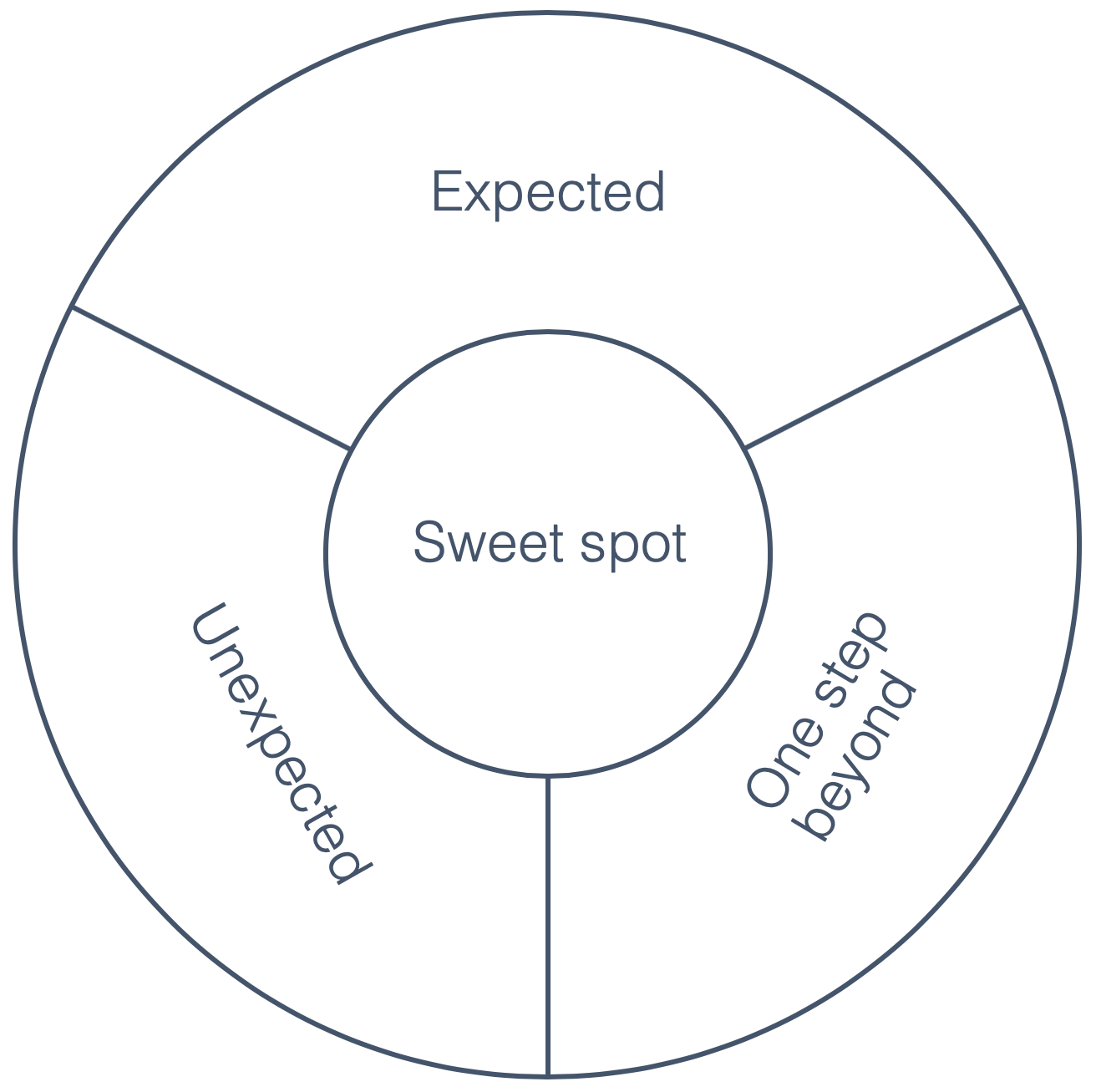Take service experience one step beyond! This instalment of our Let’s Talk About series takes a deep dive into service, the second pillar of building a future-proof brand experience.
We all know what service means, right? We all buy things, and we’re all familiar with the customer experience of being handed our purchase in a carrier bag to take home. That’s an example of a basic consumer expectation.
Today, we explore how service is evolving. To do so, we take a look at the rise of hyper-personalised delivery as the natural extension of ‘product’ and explore what this means for both the digital and physical worlds. Will locally-minded solutions built around community and human interaction become the luxury of the future?
Service is the second of the three pillars (Product, Service and Culture) that form the ‘sweet spot’ of brand experience and manifests in these areas of deliverables:
1. Expected
2. Unexpected
3. One step beyond
(Graphic: Ales Kernjak)
Chances are, you’re reading this article on your mobile phone. And as with product, mobiles are the main driving force of change for service. Former Burberry Chief, Angela Ahrendts, says that today’s consumers “wake up, pick up their mobile device and then life begins”. On nightstands around the world, consumer’s first service interaction with brands sits there waiting for them to wake up.
Burberry is arguably one of the most digitally savvy brands around. After reviewing their online offer, they concluded that it delivers a service experience “just as rich, just as exciting as any store”. Indeed, their digital store ultimately helped shape the future of Burberry’s Maison designs around the world – seamless, digital-first.
(Photo: Bruce Mars)
This groundswell of change has ensured service will never look the same again. But how does this affect brand experience? And how can brands focus on human interaction to drive growth?
The Expected
Physical in-store service experience, clarity of communication, digital alignment.
‘The customer is always right’ is an old retail trope that brands have lost sight of. Marketing teams are struggling with reduced budgets and try to speak to customers across too many platforms. PR teams are balancing new consumer-centric platforms like Twitter, giving the ‘always right’ consumer a direct connection to the brand and a chance to be heard like never before.
(Photo: COS)
Retail stores are struggling to compete with online rivals, and even with their own web services. Under-staffed and over-stocked, staff are on the front line of the collapse in traditional retail formats. They’re feeling the pain and it’s clear in their service proposition delivery. So who wins?
Giving confidence to the consumer and to staff in their service delivery, brands like COS, H&M and Nike have clear propositions that even without the brand logo are unmistakably their own. They utilise the clarity of their messaging around purpose and PR tools to drive service-led elements. Brands like these are directly interacting with the consumer in the physical space, often away from a traditional retail space.
These areas offer huge opportunities for brands to use the current digital sphere to maximise their traditional delivery. This is a radical sign of how service in stores and at home is shifting to become ever more personalised and curated. Perception of value, putting the customer at the centre of the service experience, and clarity of price are some of the basics that customers have come to expect.
But consumers also want to see an alignment to their values, genuine willingness to listen and adapt, and a desire to build a rich and engaging experience. It’s here that brands have much scope in building a unique service proposition.
(Photo: Business of Fashion)
The Unexpected
If the basics are so far-reaching, how do brands deliver an unexpected service experience?
One of the most overlooked elements of delivering an unexpected service experience has been speed-to-market. Consumers see a product and want it now, and brands are working harder than ever to deliver. From streamlining processes to building multiple delivery and manufacturing centres around the world. Zara’s six-week ‘design to store’ timeline is still the envy of the fashion world.
There’s been a huge rise of private styling services at mass market retailers like H&M and Topshop, through to hyper-luxury lifestyle concierge services like Quintessentially, offering highly curated lifestyles ‘off the shelf’ to every class of wallet spend.
Disney trail-blazed the market-place in the late 80’s with a ‘buy now deliver straight to your hotel room’ service at their American theme-parks. This type of home delivery service has morphed from your local artisan flower store through to mega-names in home delivery like Amazon or Net-a-porter. Even smaller chains like the UK’s Karen Millen offer same-day delivery, delivered by the company itself. Utilising digital to drive a physical link to the consumer.
Brands are using data to place themselves at the centre of the consumer’s world. This wealth of information allows brands to target consumers with a hyper-personalised level of service. How do brands deliver a rich service experience in such a digitally driven world? To answer where the future lies, it’s best to review two short case studies. One global giant to show us the way forward, and another to show us that too much digital may be a bad thing too.
(Photo: Bruce Englehardt)
Amazon has perhaps dominated the transformation of every sector of retail, moving into physical retail with the launch of AmazonGo. The automated digital grocery store allows customers to shop and scan by app and leave the store without ever encountering a staff member.
Upon launch in 2015, Amazon predicted 3000 locations by 2018. Today, that number stands at a mere 18. What went wrong? The simple answer is people. Legislation was launched immediately in a raft of cities across the US, addressing concerns that cash-less stores actively discriminate against low-income consumers. Customers were also reported to feel nervous and uncomfortable simply ‘walking out’ of stores. Amazon underestimated the importance of human interaction in the purchase process.
(Photo: Nike)
Next, let’s look at another US giant, Nike, who have launched their ‘Live’ concept store in LA in 2018. The store is designed to be a neighbourhood-first store with a pop-up mentality. Its product offer is driven by the micro-climate in LA. Member-pass vending machines and huge fitting rooms, a ‘curb service’ where time-poor customers don’t need to leave their cars, and ‘Nike scan’ put the customer at the centre of the concept.
Interestingly, after Nike’s intensive 18-month review of consumer behaviour and feedback, the swell of desire is for more human interaction. As Nike looks to a global roll-out of the concept, it’s thus the human element that will take centre stage for the next phase.
While digital has been the 21st-century driver of change, genuine, authentic human connection is paramount – local, knowledgeable and understanding.
Show Me
Perhaps there’s no finer example of building understanding between brand and consumer, than the revisit and enhancement of that decade's old sales trick – the demonstration. Door-to-door salesmen, supermarkets and department stores have long utilised the ‘product show and tell’ to drive sales. Who hasn’t seen a demonstration of a stain remover’s power in person at a supermarket? Or a demonstration at the make-up counter in department stores across the globe? TGI figures suggest that 41% of shoppers who see a demonstration of a product go on to buy it from the store.
Brands today that are revitalising their physical brand experience create spaces that house a curated schedule of brand events to help show customers how to get the best out of their purchase. Or even post-purchase to keep the consumer locked into their eco-verse building tangible brand loyalty.
(Photo: Halifax)
The future lies in how brands use these techniques to help show consumers life improvement options. Building connection and demonstrating authentic messaging without discussing purchase at all. The UK bank Halifax recently launched its curated branch of the future with a ‘community’ space in every new store. This dedicated space is given over to a curated offer.
An almost too obvious range of events that help educate about financial services, insurance options, wealth management services and getting on the mortgage ladder. Surprisingly open to even those who aren’t customers of the bank itself but perhaps, more importantly, making the bank a centre of the community. Giving this space over to local organisations such as charities who can host meetings there, communicate and launch initiatives and build a connection with the local community in a way that doesn't have an obvious benefit to the bank itself.
Authentic, meaningful demonstrations; brands that value the importance of the lifestyle of local areas. These traits build core purpose around stores and are the future of brand service propositions.
(Photo: Retail Prophet)
One Step Beyond
What does this mean for services and brand experience of the future?
Service delivers emotion. When brands shout about their mission, purpose and values whilst simultaneously showing a clear understanding of customer’s lives – consumers can make choices that align with their values.
Luxury brands like Vuitton have always been driven by delivering an almost ‘hotel and butler’ level of personalised service. Brands like Aesop offering chef experiences or PUMA offering in-house design and digital footwear experiences are a new phenomenon. A sign that the mid and mass markets are adapting to the new experience-driven marketplace.
Brands have used allocation teams to build product offers around local needs for decades. And it’s in this technique that we see the evolution of service experience. As with ‘Nike Live’, effective service is built around the human, human connection, and local solutions that serve a community.
It’s here, at the intersection of physical experience, human contact, communication and digital choice that service delivers a brand experience like no other.
In ‘Let’s Talk About…’ Ales Kernjak shares invaluable insight, tips and tricks that draw from his extensive experience in retail as well as predictions for its future. Upcoming articles cover all aspects of today’s retail landscape, from product experience to culture, visual merchandising to store design and much more. Follow the series on Brand Experts.









